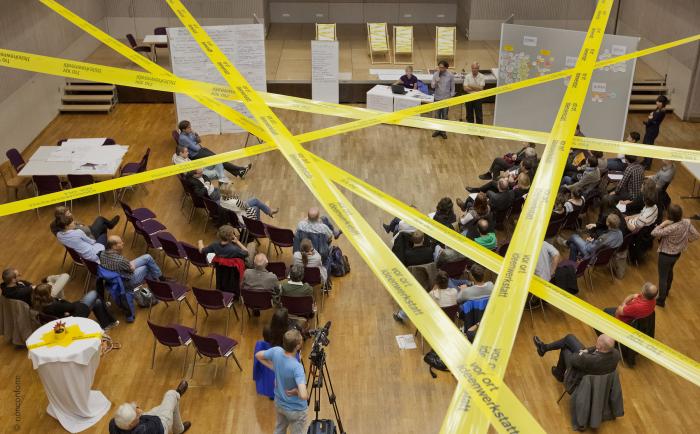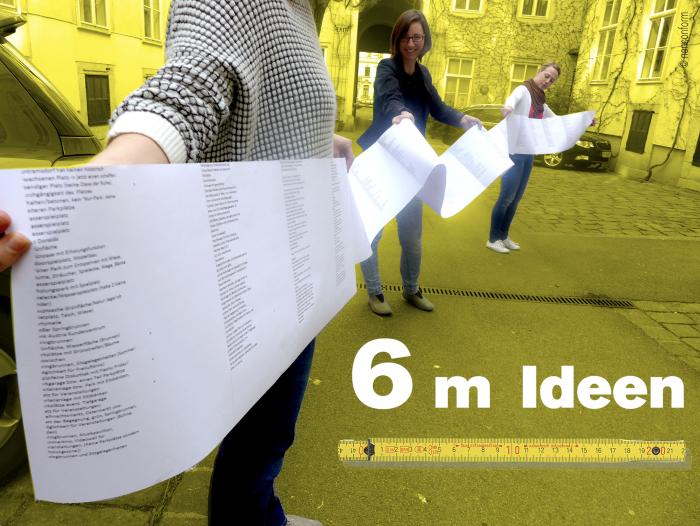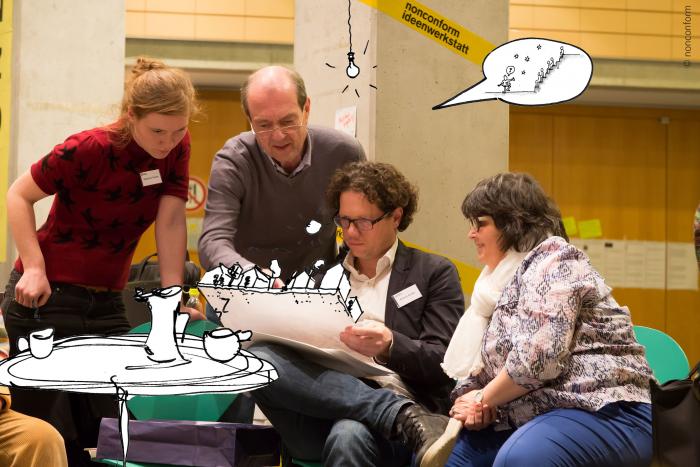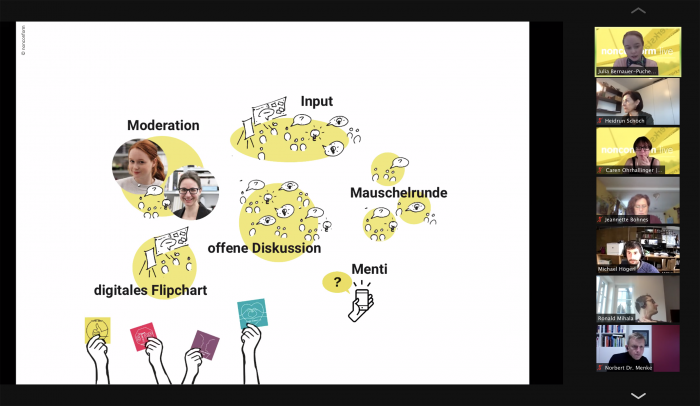I. SUMMARY INFORMATION
Project
269705
Status
Submitted
Award category
Techniques, materials and processes for construction and design
You want to submit
NEW EUROPEAN BAUHAUS AWARDS : existing completed examples
Project title
The nonconform ideenwerkstatt
Full project title
The nonconform ideenwerkstatt – co-creating solutions for the future we want to live in
Description
If the world was created in 7 days, a sustainable future for a town or locality may start in 3 days of nonconform ideenwerkstatt. This participatory process brings together all community sections with politicians, administrators, businesses and other stakeholders, to identify problems, sustainable solutions and setting in motion their assisted thorough implementation. With 150 events in 15 years in over 130 places, nonconform has refined a flexible, powerfully creative instrument for change.
Where was your project implemented in the EU?
Austria
Regions in Austria/ Germany/ Luxemburg
not applicable
not applicable
not applicable
not applicable
not applicable
When was your project implemented?
Has your project benefited from EU programmes or funds?
No
Which programme(s) or fund(s)? Provide the name of the programme(s)/fund(s), the strand/action line as relevant and the year.
II. DESCRIPTION OF THE PROJECT
Please provide a summary of your project
In 2006 nonconform, an Austrian architecture and participatory planning practice, developed its first ideenwerkstatt, a participatory method and community co-creation tool for design, problem solving and defining common visions for the future.Created to integrate the community knowledge into planning and implementing changes to their built environment, the ideenwerkstatt takes an interdisciplinary systemic approach to address the complexity of real-world problems and go beyond buildings to benefit society and environment alike.
The process starts with an analysis of the natural, physical, legal, political, historical and social context of the location, be it town, village, neighbourhood. A bespoke ideenwerkstatt ensues involving 3days of intensive, creative work for participants from all community sections to elaborate ideas for a sustainable future, playfully and cooperatively. A temporary walk-in office is also opened where information and ideas are collected, made visible and further developed in sparkly discussions. Specific open events occur where recurrent themes are identified and concrete measures defined. The results are finally presented in a festive atmosphere and synthetized in a report informing their implementation.
In time new important features emerged. For example regeneration projects of towns affected by the donut-effect lead to the “How to turn a Donut into a Krapfen” method. Crucially, for long-term transformation, the new full-time position of project caretaker (Kümmerer) was created for a person/group to ensure implementation of the final brief. Variations that suit the specificity of the target location also ensued, from ideenwerkstätte for cities to new school refurbishment aligned with contemporary pedagogical concepts. Recently, an effective entertaining 100%digital version was developed.
As many as 150events, benefitting almost as many municipalities, schools and organisations in Austria and Germany, validate the overall process
Please give information about the key objectives of your project in terms of sustainability and how these have been met
The nonconform ideenwerkstatt aims to develop with the community integrated solutions to local problems that are environmentally, economically and socially sustainable.
These objectives, are difficult to achieve in top-down expert-led interventions that do not involve the community, and are instead achieved by:
identifying and integrating local resources (existing buildings, regional materials and local people)
using resources effectively, for example by identifying synergies and reducing the built area
encouraging sustainable behaviours by raising awareness, inspiring and creating motivation. Nonconform also acts as “advocate of the future” bringing society trends as well as best-practice examples in the dialogue. Trips are made to locations of previous interventions and networks are being activated, to give a tangible dimension to an otherwise distant future
defining solutions that are feasible, backed by many people and more likely to be implemented, by bringing together local and professional expertise as well as decision makers
reducing the financial effort required for implementation in comparison to top-down projects pushed ahead and carried out by the local authority alone
rendering the projects economically more viable by integrating specific needs and interests and by creating initiatives that make sense for and are “adopted” by the locals (e.g., deciding together which uses should revive the disused ground floors in high street regeneration projects or deciding which community spaces should be integrated in housing developments)
creating meeting places and ways in which the citizens can engage themselves during and beyond the 3 days of the ideenwerkstatt, leading in turn to the identification of the participants with its outcome, the overall community, and an increased sense of belonging and social cohesion
striving for outcomes that increase the sense of well-being and quality of life
Please give information about the key objectives of your project in terms of aesthetics and quality of experience beyond functionality and how these have been met
The nonconform ideenwerkstatt has a stated objective of developing projects not at the lowest but at “the most beautiful common denominator”.
This is achieved by building on the local resources, history and culture as well as by raising awareness for beauty and sustainability in architecture. In this sense, the ideenwerkstatt has an important role in promoting debate about the quality of the build environment. Scale, space, materiality, proportion as well as other architectural elements are discussed and reflected in order to reach well-informed decisions. This was for example the case in B.R.O.T., a co-housing project, when it came to the choice of materials, arrangement of the buildings on site or defining outdoor spaces for private or community use.
Being directly infused by the everyday experience of the community, the solutions developed are usually enhancing the quality of experience of the target spaces and strengthening the local identity. This is the case of the many public space re-design processes that finally put back the pedestrian at the centre, and other regeneration projects that revived existing lost qualities.
The ideenwerkstatt itself is conceived with quality of experience in mind: when people enjoy themselves, they are more likely to be creative and to identify in a positive way with the project. The three days have a festival atmosphere, the programme is diverse and the formats entertaining. Laughing and humour are very important to overcome the inhibitions and stimulate the creativity of the participants. The nature and flavour of the process are made to positively reflect in the outcome.
Please give information about the key objectives of your project in terms of inclusion and how these have been met
A main objective of a nonconform ideenwerkstatt is to get all interested or affected people on board: the community at large, as well as decision groups, such as politicians, the local administration or property owners, and experts from various relevant fields, businesses and associations.
This is achieved by:
reaching to the people ‘there where they are’ via a multifaceted mobilization process ranging from artistic and performance-based interventions in the public space and presence in the media and digital forums, up to posters and direct invitations in everyone's mailbox
making the process visible, present and attractive by choosing a relevant location and ensuring a welcoming atmosphere for the pop-up office
having an interdisciplinary team on site – the nonconformers are genuinely open and curious to hear all ideas and see in different perspectives and ways of thinking a potential for innovation
avoiding professional jargon language
collecting thoughts and ideas in ideenboxen placed in key locations as well as on a digital ideenwand
devising different formats from one-to-one dialogues and workshops for specific groups (e.g. children, teenagers, teachers, property owners, etc.) to larger community events. The views of children are explored in playful ways such as the ‘journey in the future’. Older kids can carry a thorough analysis of their schools or settlements which they can present in guided tours or through mapping exercises. This can reveal perspectives that are difficult to perceive by other age categories.
By giving everyone a voice and creating an inclusive start, the solutions developed and initiatives that follow are often also inclusive. For example, in Tandler, a re-use and UpCycle shop in the regenerated centre of Trofaiach, people with disabilities are involved along local artisans. Or in B.R.O.T. a countryside co-housing project, an apartment was provided to a refugee family, significantly facilitating their integration.
Please give information on the results/impacts achieved by your project in relation to the category you apply for
To be able to reach the Green Deal goals and make our built environment more sustainable it is essential to keep our future developments inside the existing settlements. This means intervening on existing buildings and quarters as opposed to building on the “green fields”. The challenges implied in this are not only technical. Indeed, it is often the social resistance that puts such projects on hold.
By getting as many people as possible on board, the nonconform ideenwerkstatt transforms unwanted change into societal transformation.
Be it for finding new uses and operators for disused buildings, regenerating town centres, bringing villages back to life or improving the spaces of a school to match contemporary educational concepts, the nonconform ideenwerkstatt not only provides the foundations for a sustainable development but also sets a precedent and offers a tool for future successful engagement practices.
By being taken seriously - and seeing their contributions and ideas being realized - citizens are encouraged to be pro-active and engage meaningfully in the life of their towns or villages. At the same time, in the process a shared understanding and awareness for sustainable lifestyles and building principles is being developed. Values that are lived during the intense co-creation days are often infusing the next projects and following individual initiatives, in a snow-balling effect.
The positive results are multifaceted: the energy and effort required for the implementation is ensured and is distributed, support from the community is achieved and the quality and feasibility of the solutions is increased. In the past 15 years, new uses were found through nonconform ideenwerkstaette for about 95.000 m2 disused spaces in approx. 350 buildings.
This shows how through transparency, openness and thorough inclusiveness, apparently divergent interests can be exposed, negotiated and transformed into convergent energy flows.
Please explain the way citizens benefiting from or affected by the project and civil society have been involved in the project and what has been the impact of this involvement on the project
An effort is made to have open formats, where all people interested can take part, and specialized formats where various constellations are brought together. Specific workshops are also organized for specific groups (see also section on inclusion).
For example, property owners are gathered to reach decisions about the revitalization of their buildings or stakeholders workshops are organized for people from the local administration to discuss and ensure the conditions needed for the project to be implemented. In preparation to the ideenwerkstatt, schools are invited to start open dialogues about their building or town. Ideas and reflections are then presented in form of stories, drawings or performances during the ideenwerkstatt.
The first part of the ideenwerkstatt focuses on listening carefully, asking the right questions and collecting ideas. People share their observations and daily experiences in writing or verbally, during informal or structured events. There would be typically a site visit (Spurensuche) and a shared breakfast or lunch and in the evening open moderated events. However, the nonconform ideenwerkstatt goes far beyond merely collecting information. During the workshops, people not only express their thoughts but also actively look together for solutions. Under the nonconform motto ‘miteinander weiter denken’ (thinking further with each other) new perspectives are discovered and compromises are reached, recurrent themes are identified, solutions further developed and action groups formed
The impact of the nonconform ideenwerkstatt is multifarious. People feel empowered and gain an increased sense of self-efficacy known to have a considerable influence on their quality of life. They identify and take ownership of the solution, paving the way into implementation and sparing precious time and resources. Places that really suit their needs are created, as well as the sense that they can develop them further when and if the need to do so arises again
Please highlight the innovative character of the project
The innovative character of the nonconform ideenwerkstatt was recognized right from the start. The participatory method received various awards, such as the jury prize at the Consulting State Awards in 2008, the “Austrian of the year” award in 2012 and the regional cultural prize in Carinthia in 2013.
The ideenwerkstatt stays innovative as it continuously renovates itself, to suit the specific needs of a specific location and in response to feedback or newly emerging realities. For example, the increased importance of digitalization was first addressed with online platforms and games, meant to complement the live workshops, and reach specific groups in the community such as youngsters. This was then developed into an ideenwand and dedicated project website, where people can bring ideas and access information about the project. In response to the challenges of lockdown and restrictions, last year nonconform developed the digital ideenwerkstatt – where projects can be developed together with the community and the stakeholders through various effective and entertaining formats partly or entirely online.
The core identity of the ideenwerkstatt stays the same, ensuring continuity and consistency through change. This lays in its inclusive, transparent character and in the compact format. Concentrating the process in only three days in a festival-like atmosphere is crucial for its creative intensity and innovative thinking. At the same time, it makes it possible for all relevant actors and the community to take part simultaneously in the co-creation. Important is also that at the end of the three days a result is being presented and that short-term measures are identified too, to make the long-term process more tangible
Please explain how the project led to results or learnings which could be transferred to other interested parties
The main learning from our long-term experience is that high quality participatory processes are worth the while. Key factors for their success are:
an open process, where the solution is genuinely developed with everyone on the spot – no hidden agendas
recognizing the expertise that each participant brings– e.g. the contributions of the community, as expert in local daily life, are just as important as the ones of experts from the various professional fields
conversations are “on a level playing field” - hierarchies and exercising pressure are left out
a brief that is relevant and that clearly states the objective and parameters (including which aspects are already decided)
a special atmosphere – the role of humour, food and drinks are not to be underestimated in overcoming inhibitions and stimulating creativity
creating momentum, energy and enthusiasm for the project through an intensive creative process, positive experiences and making the future tangible.
“How to transform a Donut into a Krapfen” or the “Project Kümmerer” are just two examples of learnings that can be transferred to other projects.
When participation is properly done, the benefits are multiple and far reaching. However, the necessary time, space and financial resources have to be made available – and a readiness for open and transparent processes have to be assumed. Clear and honest communication are key: the participants need to understand what the rules and the roles in the game are, to be taken seriously – and last but not least, have fun and enjoy the co-creation process.
Is an evaluation report or any relevant independent evaluation source available?
No
III. UPLOAD PICTURES
IV. VALIDATION
By ticking this box, you declare that all the information provided in this form is factually correct, that the proposed project has not been proposed for the Awards more than once under the same category and that it has not been subject to any type of investigation, which could lead to a financial correction because of irregularities or fraud.
Yes



